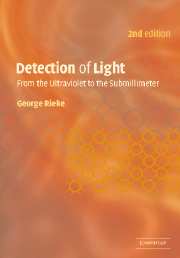Book contents
- Frontmatter
- Contents
- Preface
- 1 Introduction
- 2 Intrinsic photoconductors
- 3 Extrinsic photoconductors
- 4 Photodiodes and other junction-based detectors
- 5 Amplifiers and readouts
- 6 Arrays
- 7 Photoemissive detectors
- 8 Photography
- 9 Bolometers and other thermal detectors
- 10 Visible and infrared coherent receivers
- 11 Submillimeter- and millimeter-wave heterodyne receivers
- 12 Summary
- Appendices
- References
- Index
4 - Photodiodes and other junction-based detectors
Published online by Cambridge University Press: 09 November 2009
- Frontmatter
- Contents
- Preface
- 1 Introduction
- 2 Intrinsic photoconductors
- 3 Extrinsic photoconductors
- 4 Photodiodes and other junction-based detectors
- 5 Amplifiers and readouts
- 6 Arrays
- 7 Photoemissive detectors
- 8 Photography
- 9 Bolometers and other thermal detectors
- 10 Visible and infrared coherent receivers
- 11 Submillimeter- and millimeter-wave heterodyne receivers
- 12 Summary
- Appendices
- References
- Index
Summary
A photodiode is based on a junction between two oppositely doped zones in a sample of semiconductor. These adjacent zones create a region depleted of charge carriers, producing a high impedance. In silicon and germanium, this arrangement permits construction of detectors that operate at high sensitivity even at room temperature. In semiconductors whose bandgaps permit intrinsic operation in the 1–15 μm region, a junction is often necessary to achieve good performance at any temperature. Because these detectors operate through intrinsic rather than extrinsic absorption, they can achieve high quantum efficiency in small volumes. However, high performance photodiodes are not available at wavelengths longer than about 15 μm because of the lack of high-quality intrinsic semiconductors with extremely small bandgaps. Standard techniques of semiconductor device fabrication allow photodiodes to be constructed in arrays with many thousands, even millions, of pixels. Photodiodes are usually the detectors of choice for 1–6 μm and are often useful not only at longer infrared wavelengths but also in the visible and near ultraviolet.
Other detectors use different types of junctions. Schottky diodes are based on the interface between a semiconductor and a metal. Quantum wells are the foundation for another class of detector — they are formed when thin layers of different, but similar, crystals are grown on top of one another.
- Type
- Chapter
- Information
- Detection of LightFrom the Ultraviolet to the Submillimeter, pp. 78 - 115Publisher: Cambridge University PressPrint publication year: 2002



